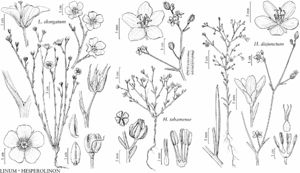Hesperolinon disjunctum
Univ. Calif. Publ. Bot. 32: 300, figs. 1c, 3, 5i–l, 10e, f, 15c–e, 20. 1961.
Herbs, (3–) 20–25 (–30) cm, stout, usually hoary, hairs minute, straight, stiff, white, sometimes glabrous except on stems distal to nodes; branches usually from distal 1/3 to 2/3 of main axis, sometimes from base, alternate, widely spreading. Leaves alternate; stipular glands minute or absent; blade linear, 10–20 × 1–2 mm, base flat, not clasping, margins eglandular or minutely gland-toothed. Inflorescences: cymes usually monochasial (scorpioid), sometimes dichasial, open, internodes long, flowers widely scattered; bract margins eglandular or minutely gland-toothed. Pedicels 1–5 (–8) mm, 5–10 (–25) mm in fruit, straight in bud, spreading at 75–90° angle, not reflexed or bent at apex. Flowers: sepals erect, usually spreading at tip, lanceolate, 2–3 mm, equal, marginal glands small, surfaces glabrous or with hoary microscopic puberulence; petals widely spreading, white or pink to lavendar-pink or rose-pink, veins usually pink, usually obovate, sometimes oblanceolate, (3–) 4–5 (–6) mm, apex notched, sometimes deeply; cup white, rim with petal attachment in shallow sinus; stamens exserted; filaments (2.5–) 3–3.5 (–4) mm; anthers usually pink, sometimes deep rose, white-margined, dehisced anthers (0.8–) 1.2–1.8 (–2) mm; ovary chambers 6; styles 3, white, (2.5–) 3–4 (–5) mm, exserted. 2n = 34.
Phenology: Flowering Apr–Jul.
Habitat: Dry, rocky hillsides in chaparral in Pinus sabiniana belt, serpentine soils.
Elevation: 100–1000 m.
Discussion
Hesperolinon disjunctum is found in the Inner North Coast Ranges and eastern San Francisco Bay area. Dwarf plants with short internodes and crowded branches sometimes occur intermixed with normal-sized plants. Restricted to serpentine soils, populations of H. disjunction are often distant from each other; Sharsmith noted that morphological disjunction accompanies the geographical disjunction.
Selected References
None.
Lower Taxa
"equal" is not a number.

